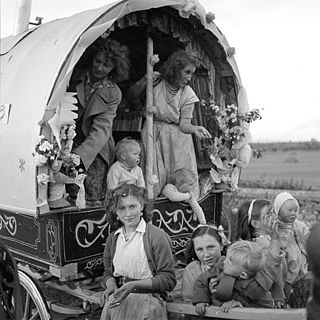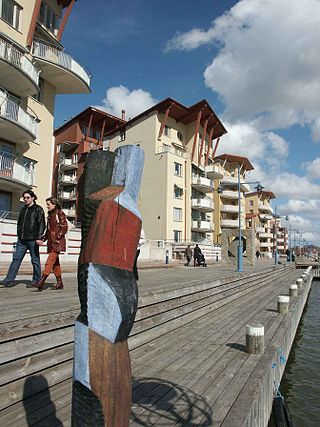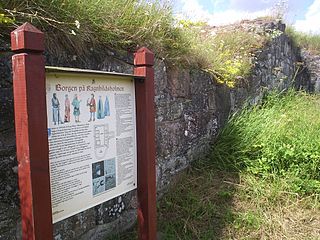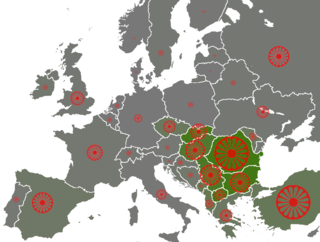
The Romani, also spelled Romany or Rromani, colloquially known as the Roma, are an ethnic group of Indo-Aryan origin who traditionally lived a nomadic, itinerant lifestyle. Linguistic and genetic evidence suggests that the Romani originated in the Indian subcontinent; in particular, the region of present-day Rajasthan. Their subsequent westward migration, possibly in waves, is now believed by historians to have occurred around 1000 CE. Their original name is from the Sanskrit word डोम (doma) and means a member of the Dom caste of travelling musicians and dancers. The Roma population moved west into the Persian Ghaznavid Empire and later into the Byzantine Empire. The Roma are thought to have arrived in Europe around the 13th to 14th century. A genetic analysis published in the Current Biology journal implies an earlier initial arrival, dating back to the 6th century. Although they are dispersed, their most concentrated populations are located in Bulgaria, Romania, Hungary, Turkey and Spain.

Irish Travellers, also known as Pavees,Mincéirs or Mincéirí, are a traditionally peripatetic indigenous ethno-cultural group originating in Ireland.

Hisingen is the fifth-largest island of Sweden, with an area of 199 km2 (77 sq mi). It is a river island, formed by the split of the Göta Älv at Bohus, and is defined to the east and south by the main arm of that river, to the north by the smaller arm, and to the west by the Kattegat. The southern part of Hisingen is extensively urbanised, representing the northern suburbs of the city of Gothenburg. The island is divided between the historical provinces of Västergötland and Bohuslän, but lies entirely within the modern county of Västra Götaland.

Kungahälla was a medieval settlement in southern Bohuslän at a site which is located in Kungälv Municipality in Västra Götaland County in Sweden. It is the site of the former fortification at Ragnhildsholmen.

Birger Nerman was a Swedish archaeologist, historian and philologist who specialized in the history and culture of Iron Age Sweden.

Romanichals are a Romani subgroup within the United Kingdom and other parts of the English-speaking world. Most Romanichal speak Angloromani, a mixed language that blends Romani vocabulary with English syntax. Romanichals resident in England, Scotland, and Wales are part of the Gypsy, Roma, and Traveller community.

The Romani people are a distinct ethnic and cultural group of peoples living all across the globe, who share a family of languages and sometimes a traditional nomadic mode of life. Though their exact origins are unclear, central India is a notable point of origin. Their language shares a common origin with, and is similar to, modern-day Gujarati and Rajasthani, borrowing loan words from other languages as they migrated from India. In Europe, even though their culture has been victimized by other cultures, they have still found a way to maintain their heritage and society. Indian elements in Romani culture are almost non-existent, with the exception of their language. Romani culture focuses heavily on family. The Roma traditionally live according to relatively strict moral codes. The ethnic culture of the Romani people who live in central, eastern and southeastern European countries developed through a long, complex process of continuous active interaction with the culture of their surrounding European population.

The Romani flag or the flag of the Roma is the international ethnic flag of the Romani people, historically known as "Gypsies", which form a stateless minority in countries across Eurasia, Africa, the Americas, and Australasia. It was approved by the representatives of various Romani communities at the first and second World Romani Congresses (WRC), in 1971 and 1978. The flag consists of a background of blue and green, representing the heavens and earth, respectively; it also contains a 16-spoke red dharmachakra, or cartwheel, in the center. The latter element stands for the itinerant tradition of the Romani people and is also an homage to the flag of India, added to the flag by scholar Weer Rajendra Rishi. It superseded a number of tribal emblems and banners, several of which evoked claims of Romani descent from the Ancient Egyptians.

Anti-Romani sentiment is a form of bigotry which consists of hostility, prejudice, discrimination, racism and xenophobia which is specifically directed at Romani people. Non-Romani itinerant groups in Europe such as the Yenish, Irish and Highland Travellers are frequently given the name "gypsy" and as a result, they are frequently confused with the Romani people. As a result, sentiments which were originally directed at the Romani people are also directed at other traveler groups and they are frequently referred to as "antigypsy" sentiments.
The Norwegian and Swedish Romanisæl Travellers are a group or branch of the Romani people who have been resident in Norway and Sweden for some 500 years. The estimated number of Romanisael Travellers in Sweden is 65,000, while in Norway, the number is probably about 10,000.
The Finnish Kale are a group of the Romani people who live primarily in Finland and Sweden. Their main languages are Finnish, Swedish and Finnish Romani. Kalo/Kale is the collective name for traveler people in Finland, England and Spain.

The Romani people have several distinct populations, the largest being the Roma and the Calé, who reached Anatolia and the Balkans in the early 12th century, from a migration out of the Indian subcontinent beginning about 1st century – 2nd century AD. They settled in the areas of present-day Turkey, Greece, Serbia, Romania, Croatia, Moldova, Bulgaria, North Macedonia, Hungary, Albania, Kosovo, Bosnia and Herzegovina, Czech Republic, Slovenia and Slovakia, by order of volume, and Spain. From the Balkans, they migrated throughout Europe and, in the nineteenth and later centuries, to the Americas. The Roma population in the United States is estimated at more than one million.
Scottish Travellers, or the people in Scotland loosely termed Romani persons or travellers, consist of a number of diverse, unrelated communities that speak a variety of different languages and dialects that pertain to distinct customs, histories, and traditions.
Romani studies is an interdisciplinary ethnic studies field concerned with the culture, history and political experiences of the Romani people. The discipline also focuses on the interactions between other peoples and Romas, and their mindset towards the Romas.

Martin Rundkvist is a Swedish archaeologist and associate professor at the University of Łódź in Poland. His research focuses on the Bronze, Iron, and Middle Ages of Scandinavia, including significant excavations in the province of Östergötland.
The Romani people are also known by a variety of other names; in English as gypsies or gipsies, and Roma; in Greek as γύφτοι (gíftoi) or τσιγγάνοι (tsiggánoi), in Central and Eastern Europe as Tsingani ; in France as gitans besides the dated terms bohémiens and manouches; in Italy as rom and sinti besides the dated terms zingari, zigani, and gitani; in Spain as gitanos; and in Portugal and Brazil as ciganos.

Sandby borg is an Iron Age ringfort, one of at least 15 on the island of Öland, Sweden. It sits about 2 kilometers southeast of Södra Sandby village in Sandby parish in southeastern Öland. It is close to the village of Gårdby.
Inger Zachrisson is a Swedish archaeologist specializing in the history of the Sami people. As Associate Professor of Archaeology at Uppsala University and former curator of Stockholm's History Museum, she has researched Sami archaeology and history since the Iron Age.

Romani people have been recorded in the United Kingdom since at least the early 16th century. Records of Romani people in Scotland date to the early 16th century. Romani number around est. 225,000 in the UK. This includes the sizable population of Eastern European Roma, who immigrated into the UK in the late 1990s/early 2000s, and also after EU expansion in 2004. Romani people in the UK are considered part of the Gypsy, Roma and Traveller (GRT) community.
Environmental racism is a form of institutional racism leading to landfills, incinerators, and hazardous waste disposal being disproportionally placed in communities of colour. This includes the lack of minority and indigenous representation in environmental decision-making and inequality in resource development. Internationally, it is also associated with extractivism, which places the environmental burdens of mining, oil extraction, and industrial agriculture upon Indigenous peoples and poorer nations largely inhabited by people of colour.












